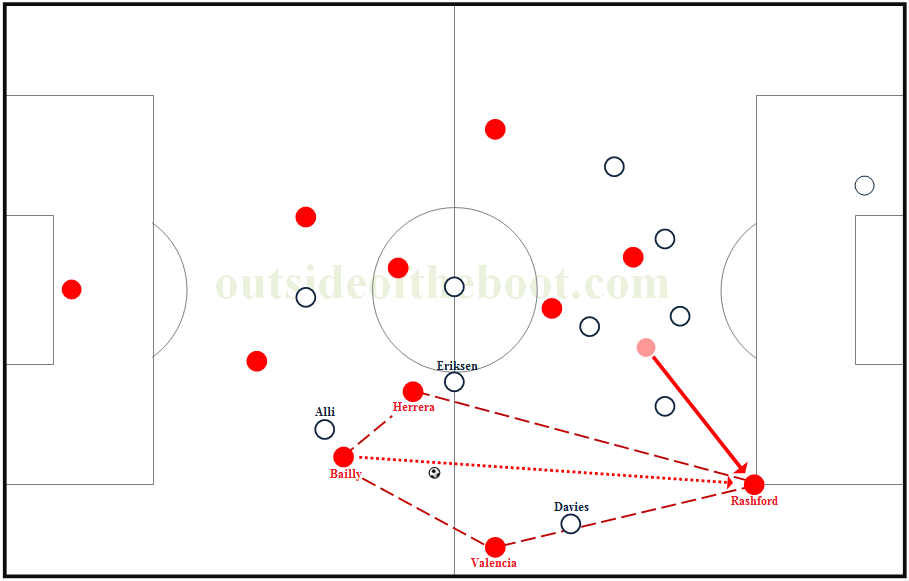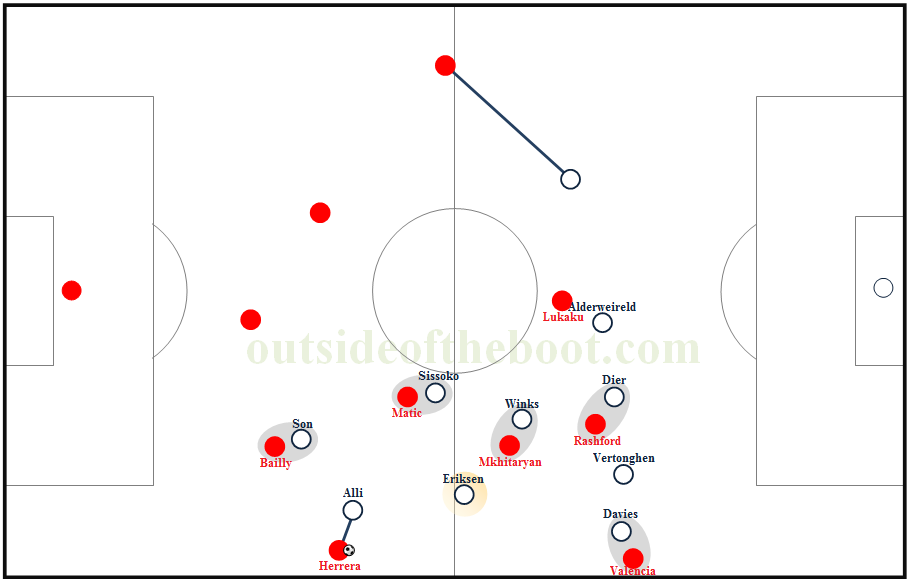Ryan Tank provides a tactical analysis about the Premier League match that ended Manchester United 1-0 Tottenham Hotspur
Line Ups
Manchester United: De Gea; Bailly, Smalling, Jones; Herrera, Matic, Valencia, Young; Mkhitaryan; Lukaku, Rashford.
Tottenham: Lloris; Alderweireld, Dier, Vertonghen; Winks, Eriksen, Sissoko, Aurier, Davies; Alli, Son.
United’s possession and space occupation
Against Tottenham’s press, Jose Mourinho’s troops relied on a direct approach build up as one of their approach was to play a lot of deep passes to Lukaku and Rashford in the last line. The aim was simple, access the depth and make quick entries into the box at full speed. There were three common methods implemented by the home side to generate such play:
- Aerial balls to Lukaku and let the Belgium flick it on forward. Sometimes they directed it right from the back line, but on other occasions, United generated such a play by playing short combination between two or three players (triangle), in the below middle third, and made the final passing-combination by playing the ball to the player facing forward to release a float long ball right to the head of Lukaku.
- The second method was from the flank or half space, United’ players played a long ground pass to the last line to any forward who made a diagonal run toward the half space or flank. There was also a diamond within this half space play, in middle third. The diamond was usually established by half back (as the passer), near wing back, near central midfielder, and the ball side striker who provided vertical-depth as well as the passing target.
- The third one was using one forward to receive and make an immediate backward layoff to the wing back followed by a diagonal pass, by the receiving wing back himself, to the furthest player in the last line.

Example of long ground pass to the last line and diamond between half back, central midfielder, wing back, and ball side striker
In a more gradual build up, United used Matic as the outlet of Tottenham’s press. One simple method was using Matic to generate wallpass so United’s back line were able to shift cleanly from one half back to the other one as well as play it wide using the ball side wing back to progress higher.
In the build up, United pushed their wing backs high up the pitch. Antonio Valencia on the right side, at times even occupied the ball side half space close to the striker. This seemed to be intentional as it might generate a strong connection between Valencia and the near striker should the ball be played and managed to access the forward line. The left wing back, in this regard, also pushed to the higher ground occupying the far side flank or half space in the same line as 8 or sometimes slightly higher. This far side wing back was tasked to maintain the width as well as being the passing option when United were able to progress from a wide overload, from the right side, and attacked diagonally into the final third. Such a diagonal run usually done by Henrikh Mkhitaryan, as shown below.
Mkhitaryan and Herrera were given a specific duty in United’s attack in the final third. They moved across both half spaces making supportive movement to the attacking overload on both wings. If Mkhitaryan moved to the left side, then Herrera moved into the box to get himself involved in the execution phase, and vice versa. In such an attacking principle, Mkhitaryan was slightly different to Herrera. The Armenian seemed to get involved in the chances-creation more than Herrera did. Mkhitaryan was more ball-oriented and moved even wider to the flank to create space for the wing back to get into the half space.
Another important point of United’s final third attack was the support by both half backs. Jones and Bailly often moved higher up the pitch towards the final third depending on the defensive positioning of Son and Alli. Had the two Tottenham forwards dropped very deep into their own early third, Bailly and Jones pushed forward to make sure they were close enough to both opponent’s forwards as well as established a strong cover to the half space. The positioning by both half backs, in turn, impacted positively to United’s transitional phase; creating a strong gegenpressing structure.

United’s final third attack and gegenpressing. Hererra made a wall pass with Mkhitaryan, but the back pass by Miki was intercepted by Alli. The ball was quickly-switched to Aurier on the right side but Young managed to make a tackle and regained possession
The weak point of United’s performance in the first half was their box entry and the final product. Before the break, Lukaku and co could only manage 2 shot attempts compared to Tottenham’s 10.
Tottenham’s play
The visitors pressed with a 5-1-2-2 basic shape. Son and Alli, in the 1st line, orientated to United’s first line. The two alternately swapped their pressing position. The ball side 8, either Eriksen or Sissoko, made an onward press to press the opponent’s near half back depending on the positioning of the ball and the positioning of the striker-duo as well. In the second line, Eriksen and Sissoko’s initial task was to man mark both Herrera and Matic. When United’s possession was switched to Phil Jones’ side, while Alli-Son were on the right side of United’s area, Sissoko would step up to press the left half back (thus also allowed space for Matic behind Sissoko’s cover shadow). United tried to create progression access using Herrera or Matic as the central midfield duo dropped into the space beside of Bailly and Jones. In such situations, Tottenham’s ball side 9 dropped slightly deeper to keep Herrera visible so as to be able to maintain an easy pressing access to the Spaniard. In this way, Tottenham often trapped United’s possession to the touchline as well as generated a spare man.

The cover for the press by any Tottenham’s 8 was taken by Winks. Once the press managed to deflect United’s circulation to the flank, Tottenham’s near forward had to put United’s ball side half back behind his cover shadow.
Tottenham often managed turnovers in wide areas as United failed to bypass Tottenham’s touchline press. And as explained above, this also forced a lot of undesired aerial balls forward from United’s back line. But again, United’s gegenpressing made it hard for Tottenham to easily benefit from this, as, for example, the undesired long ball was cleared away by Dier but United’s compact structure enabled them to win the 2nd ball and recycled possession with help from the half back.
When Tottenham managed to win the 2nd ball in the opponnent’s middle third, they often progressed the attack using Eriksen’s passing ablity to create chances. One typical chance creation method was the aerial diagonal ball from half space to the far side of the box-width. If the attacking development (after 2nd ball recovery) around the central area was unavailable, Tottenham used lateral passes towards the flank before cutting it back into the near half space for Eriksen to release the said diagonal ball.
If the recovery was gained in the deeper area of Tottenham’s defense, a different progression pattern was identified. Tottenham would try to exploit the blind side by playing long diagonal balls from side to side or if it possible, they played a ground direct pass toward the final third to Tottenham’s player in the attacking pocket.
United’s man to man against Tottenham’s offense
One of the interesting things to note was how United nullified the role and impact of the half back in Tottenham’s circulation and progression. In United’s initial press, Rashford and Lukaku stayed wide on each of the half spaces. The orientation was heavily emphasized on Vertonghen and Alderweireld. Eric Dier was allowed space to move onward with the central lane contained by Mkhitaryan as the Armenian occupied Winks at Tottenham’s 6 space.
By staying close to both half backs, United’s first line tried to block Tottenham from directly accessing their half back. When the ball was with Dier, Rashford or Lukaku had to make sure that the each half back was under their control by blocking any easy access to the half back. The pressing behavior of Rashford and Lukaku changed once the ball managed to be distributed to Tottenham’s half back. Rashford or Lukaku would raise the pressing intensity by closing down at high speed as they tried to isolate the half back on the touchline. Instead of being panicked from such a situation, Tottenham were able to create access to the free half back. This was possible because United’s front three occupied one side thus allowing the opposite field (half back) to be unmarked.
Another important point was how Tottenham would be able to dismark United’s press. In this regard, as expected because of the man to man marking by United’s players, Tottenham responded by displaying a lot of wall passes followed by an off the ball movement to drag the marker away to open up space for the next progression lane. For example, Sissoko moved wide to the 10 space for Alli to receive and play the next wall pass to Sissoko.
There were a lot of vertical-reverse and horizontal-reverse moves. In vertical-reverse, Tottenham swapped position between players from different lines. For example, Eriksen from 8 line moved into 9 space while Son, from 9 line, dropped into 10. In horizontal-reverse example, Tottenham players swapped position between an inverted wing back and a central midfielder who moved wide to balance the spacing. Both similar visual examples can be seen here.
Mkhitaryan, as United’s 10, often showed a crucial role when it came to the defensive third. The way the Armenian contained and stayed close to Winks not only reduced the possibility for Tottenham to use Winks as the connector for Tottenham’s horizontal-ish possession, but, at times, Mkhitaryan even managed to make interceptions and generate counter attack as well.
Conclusion
United secured 3 points after Martial managed to capitalize the chance from Lukaku’s flick on. Whatever people say about United, Jose Mourinho’s boys played their own model and even scored the only goal from a planned pattern of their model.
- Tactical Analysis: Roma 3-0 Chelsea | Chelsea’s Possession Play Failed to Tear Down Roma’s Fortress - November 4, 2017
- Tactical Analysis: Tottenham Hotspur 3-1 Real Madrid | Spurs Make A Statement - November 2, 2017
- Tactical Analysis: Manchester United 1-0 Tottenham Hotspur | United Secure An Important 3 Points - October 29, 2017


























































